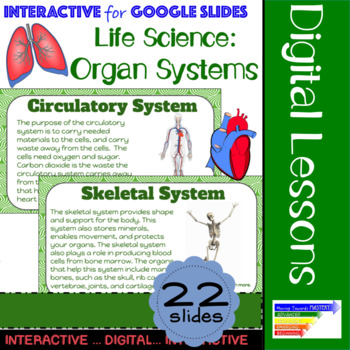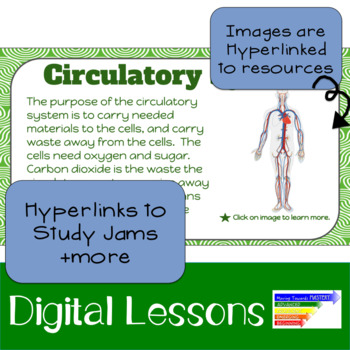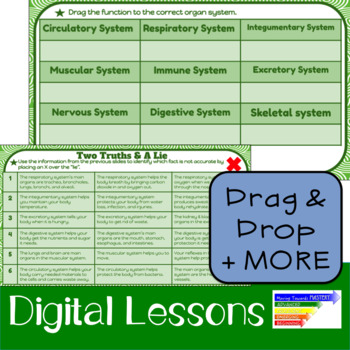Life Science: Human Body & Organ Systems Digital Lesson for Google Classroom
- PDF
- Google Apps™
- Internet Activities

What educators are saying
Description
Extensive digital guided lesson for the human body systems. Students can learn about the various organ systems and how they work together.
The slides are scaffolded to build understanding. Students will progress from gathering information to identification of main body organs and functions of each body system to analyzing how the organ systems work together. The guided slides will begin with information, move towards independent practice, and conclude with assisted analysis.
Slides include...
♦ Definitions and Visual Representations
♦ Video Links to Gather More Information . ( Study Jams & YouTube Video Links)
♦ Organ Systems
→ Circulatory
→ Respiratory
→ Digestive
→ Excretory
→ Integumentary
→ Muscular
→ Immune
→ Reproductive
→ Nervous
→ Skeletal
22 interactive student slides are included along with a teacher's guide and answer key.
The Life Science: Organ Systems Interactive can be used as an introductory lesson, guided practice, or culminating task.
♦ Need a self-checking review activity? Click below for a mystery picture puzzle that will review the material presented in the Organ System Google Interactive:
Organ System Mystery Picture Puzzle
♥ Love the lesson? Check out other interactive resources:
Life Science: Plant & Animal Classification
Elementary Interactives Using Google Apps
Middle/High School Interactives Using Google Apps
**Follow Me to be notified of NEWLY released Google Interactives.**
--------------------------------------------------------------------------------------------------------------------------------------------------------------
Licensing Terms :
By purchasing this product, you own a license for one teacher only for personal use in their own classroom. Licenses are non-transferable, unless you have purchased a transferable license, and therefore can not be passed from one teacher to another. If the teacher who purchased this license leaves the classroom or changes schools, the license and materials leave with that teacher. No part of this resource is to be shared with colleagues or used by an entire team, grade level, school or district without purchasing the correct number of licenses.
Copyright Information :
© Moving Towards Mastery
Please note - all material included in this resource belongs to Moving Towards Mastery. By purchasing, you have a license to use the material but you do not own the material. You may not upload any portion of this resource to the internet in any format, including school/personal websites or network drives unless the site is password protected and can only be accessed by students, not other teachers or anyone else on the internet.





